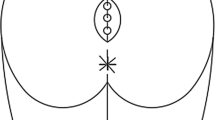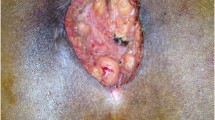Abstract
PURPOSE: Despite the variety of surgical techniques proposed for the treatment of pilonidal disease, recurrence after its operative management remains a common occurrence. Relatively few data exist that focus on an optimal surgical approach that should be followed in cases of recurrent pilonidal disease. The aim of this study was to describe the technical details, analyze the advantages, and present the early results of a modified Bascom asymmetric midgluteal cleft closure technique applied in patients with recurrent pilonidal disease in a military hospital setting. METHODS: Among the 72 male military service patients (median age, 21; range, 18–26 years) who underwent surgery for pilonidal disease in the Military Hospital of Samos Island, Greece, there were 24 who presented with recurrent pilonidal disease eight months to four years after one to four operations each, which were performed before their enrollment in the Army (total of 43 operations). One or two midline pits were evident in 41.6 percent of the patients, whereas the rest had more complex disease. Three patients presented with acute purulent disease and required initial incision and drainage. The modified Bascom technique was applied, which involved an asymmetric ellipse-like, gluteal fat–preserving excision of the affected skin, the pilonidal sinus, and lateral tracts, a thick skin and fat tongue of tissue mobilization, and finally, complete lateralization of wound closure and flattening of midgluteal groove. RESULTS: All patients tolerated the procedure well, with minimal to moderate postoperative discomfort. Full return to military duty was possible in three weeks after surgery. There was one case of limited primary healing failure. No recurrences have developed in a short median follow-up period of ten months. CONCLUSION: The suggested modified Bascom technique is an attractive, safe, easily performed operation with minimal morbidity and can be reliably used as a second-line surgical option for recurrent pilonidal disease.
Similar content being viewed by others
References
G Allen-Mersh (1990) ArticleTitlePilonidal sinus Br J Surg 77 123–132
LA Buie (1944) ArticleTitleJeep disease South Med J 37 103–109
MA Casberg (1949) ArticleTitleInfected pilonidal cysts and sinuses Bull US Army Med Department 9 493–496
J Bascom (1987) ArticleTitleRepeat pilonidal operations Am J Surg 154 118–121
MJ Notaras (1970) ArticleTitleA review of three popular methods of treatment of postanal (pilonidal) sinus disease Br J Surg 57 886–890
SC Sood UJ Green R Perni (1975) ArticleTitleResults of various operations for sacrococcygeal pilonidal disease Plast Reconstr Surg 56 559–566
CA McLaren (1984) ArticleTitlePartial closure and other techniques in pilonidal surgery Br J Surg 71 561–562
DC Britton CG Marks JK Ritchie HR Thompson (1977) ArticleTitleThe treatment of pilonidal sinus at St Mark’s Hospital Proc R Soc Med 70 478–480
JP Thomson J Lee (1982) ArticleTitleRadical surgery for pilonidal sinus Ann R Coll Surg Engl 65 64–65
O Kronborg KI Christensen O Zimmermann-Nielseon (1986) ArticleTitleChronic pilonidal disease Br J Surg 72 303–304
T Schoeller G Wechselberger A Otto C Papp (1997) ArticleTitleDefinite surgical treatment of complicated recurrent pilonidal disease with a modified fasciocutaneous V-Y advancement flap Surgery 121 258–263
GE Karydakis (1973) ArticleTitleNew approach to the problem of pilonidal sinus Lancet 2 1414–1415
F Roe (1971) ArticleTitleA new operative technique for pilonidal sinus Surg Gynecol Obstet 132 291–296
RH Fishbein JC Handelsman (1979) ArticleTitleA method for primary reconstruction following radical excision of sacrococcygeal pilonidal disease Ann Surg 190 231–235
CV Mann R Springall (1987) ArticleTitleD-excision for sacrococcygeal pilonidal sinus disease J R Soc Med 80 292–295
DF Casten BY Tan A Ayuyao (1973) ArticleTitleA technique of radical excision of pilonidal disease with primary closure Surgery 73 109–114
JL Farringer DR Pickens (1978) ArticleTitlePilonidal cyst. An operative approach Am J Surg 135 262–264
OF Akinci A Coskun A Uzunkoy (2000) ArticleTitleSimple and effective surgical treatment of pilonidal sinus Dis Colon Rectum 43 701–707
TM Al-Jaberi (2001) ArticleTitleExcision and simple primary closure of chronic pilonidal sinus Eur J Surg 167 133–135
TL Hull J Wu (2002) ArticleTitlePilonidal disease Surg Clin North Am 82 1169–1185
Author information
Authors and Affiliations
About this article
Cite this article
Theodoropoulos, G.E., Vlahos, K., Lazaris, A.C. et al. Modified Bascom’s Asymmetric Midgluteal Cleft Closure Technique for Recurrent Pilonidal Disease. Dis Colon Rectum 46, 1286–1291 (2003). https://doi.org/10.1007/s10350-004-6729-4
Issue Date:
DOI: https://doi.org/10.1007/s10350-004-6729-4




